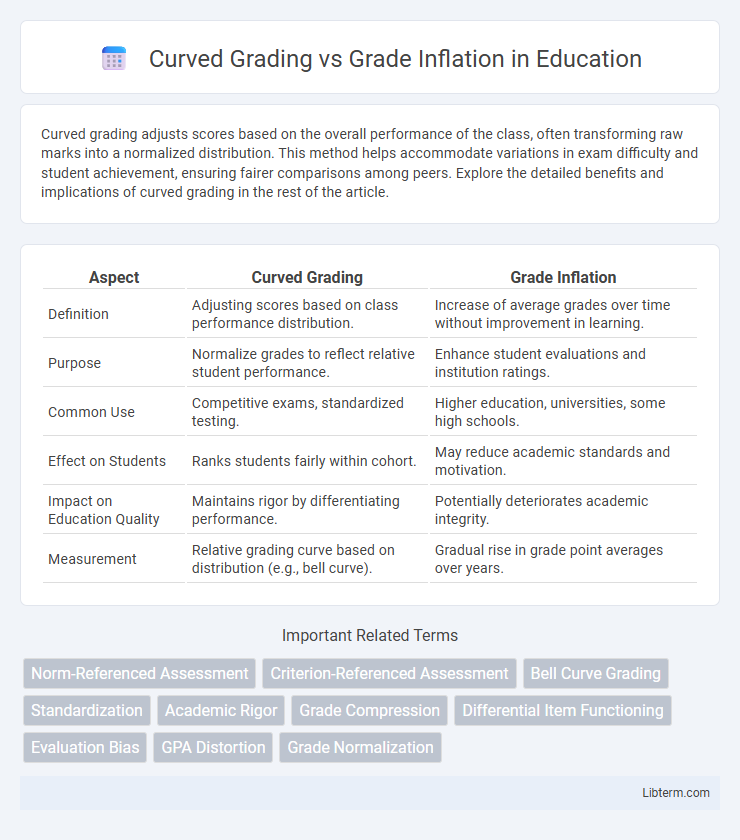Curved grading adjusts scores based on the overall performance of the class, often transforming raw marks into a normalized distribution. This method helps accommodate variations in exam difficulty and student achievement, ensuring fairer comparisons among peers. Explore the detailed benefits and implications of curved grading in the rest of the article.
Table of Comparison
| Aspect | Curved Grading | Grade Inflation |
|---|---|---|
| Definition | Adjusting scores based on class performance distribution. | Increase of average grades over time without improvement in learning. |
| Purpose | Normalize grades to reflect relative student performance. | Enhance student evaluations and institution ratings. |
| Common Use | Competitive exams, standardized testing. | Higher education, universities, some high schools. |
| Effect on Students | Ranks students fairly within cohort. | May reduce academic standards and motivation. |
| Impact on Education Quality | Maintains rigor by differentiating performance. | Potentially deteriorates academic integrity. |
| Measurement | Relative grading curve based on distribution (e.g., bell curve). | Gradual rise in grade point averages over years. |
Understanding Curved Grading: Concepts and Mechanisms
Curved grading adjusts student scores based on the overall performance of the class, ensuring a normalized distribution of grades that reflects relative achievement rather than absolute criteria. This method often relies on statistical tools such as standard deviation and mean scores to establish grade thresholds, preventing score clustering at similar levels. Understanding curved grading involves recognizing its role in mitigating uneven exam difficulty and maintaining consistent academic standards across varying assessment conditions.
Defining Grade Inflation: Causes and Consequences
Grade inflation refers to the gradual increase in average grades awarded to students without a corresponding rise in learning or achievement levels. Causes include lenient grading standards, increased pressure from students and parents, and institutional incentives to boost graduation rates. Consequences encompass diminished academic rigor, reduced grade differentiation, and challenges for employers and graduate programs in assessing true student performance.
Historical Overview: Curving and Inflating Grades
Curved grading originated in the early 20th century as a statistical method to adjust student scores relative to class performance, ensuring a balanced distribution of grades. Grade inflation emerged later as a trend where average grades rise over time without corresponding increases in learning, often linked to shifts in institutional policies and societal pressures. Historical analysis reveals that while curving addresses relative achievement within cohorts, grade inflation reflects systemic shifts that challenge the interpretation of academic standards.
Curved Grading vs Grade Inflation: Core Differences
Curved grading adjusts student scores relative to the overall performance of the class, creating a distribution curve that ranks students against each other, thus maintaining competitive differentiation. Grade inflation refers to the gradual increase in average grades over time without a corresponding rise in learning or achievement, often diminishing the value of high grades. While curved grading emphasizes relative performance by normalizing scores, grade inflation reflects an absolute trend in raising grades irrespective of actual mastery.
Academic Impacts of Grade Curving
Grade curving standardizes student performance by adjusting scores relative to the highest achievers, which can enhance competition and motivation but may obscure true mastery of material. This practice often leads to grade compression, reducing the differentiation between student abilities and potentially impacting academic integrity and fairness. Unlike grade inflation, which artificially elevates overall grades, curving can create inconsistencies in transcript evaluations across different courses and institutions.
The Effects of Grade Inflation on Student Achievement
Grade inflation distorts academic standards by increasing overall GPA averages without corresponding improvements in student learning or mastery. This process undermines the accuracy of grades as indicators of knowledge and skill, leading to reduced motivation and diminished effort among students. As a result, educators face challenges in maintaining rigorous expectations, which can ultimately impair genuine student achievement and preparedness.
Equity and Fairness: Analyzing Curves and Inflation
Curved grading and grade inflation both impact equity and fairness in academic assessment by altering the distribution of grades, where curved grading adjusts scores relative to peer performance while grade inflation raises overall grades regardless of mastery. Curving can promote fairness in competitive cohorts by normalizing disparities, but may disadvantage students in smaller or less consistent classes. Grade inflation undermines academic standards and can diminish the value of high achievement, disproportionately benefiting students in less rigorous environments.
Employer Perceptions: Grading Methods in the Job Market
Employers often view curved grading as a more standardized metric, interpreting it as a reflection of relative student performance within a competitive cohort, whereas grade inflation can obscure true academic achievement by inflating grades over time. This skepticism towards inflated grades prompts employers to prioritize transcripts from institutions known for rigorous grading standards to better assess candidate aptitude. Consequently, grading methods significantly influence employer perceptions, impacting hiring decisions and the evaluation of academic credentials in the job market.
Solutions and Alternatives to Traditional Grading Practices
Implementing standards-based assessment offers a transparent alternative to curved grading by evaluating students against predefined learning objectives rather than class performance distribution. Portfolio assessments encourage holistic evaluation through diverse student work samples, reducing the emphasis on numeric scores and mitigating grade inflation risks. Incorporating formative feedback mechanisms promotes continuous improvement and mastery, shifting focus away from comparative rankings towards individualized learning progress.
Future Trends: Navigating Grading Ethics in Education
Future trends in education emphasize transparent assessment methods, with curved grading facing scrutiny for potentially masking true student performance and contributing to grade inflation. Institutions are exploring alternative grading practices such as standards-based assessment and competency-based evaluation to promote fairness and accuracy while maintaining academic rigor. Advancements in educational technology and data analytics support adaptive grading systems that align with individual learning outcomes and minimize ethical concerns in grading practices.
Curved Grading Infographic

 libterm.com
libterm.com